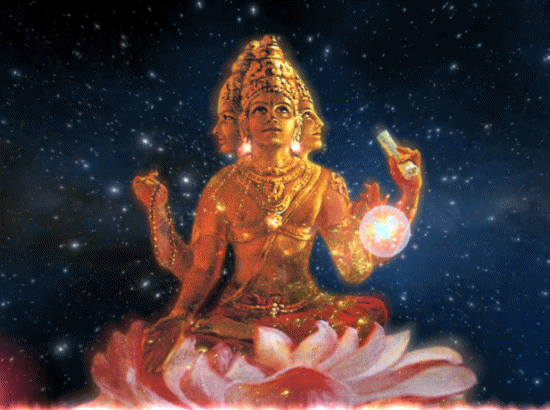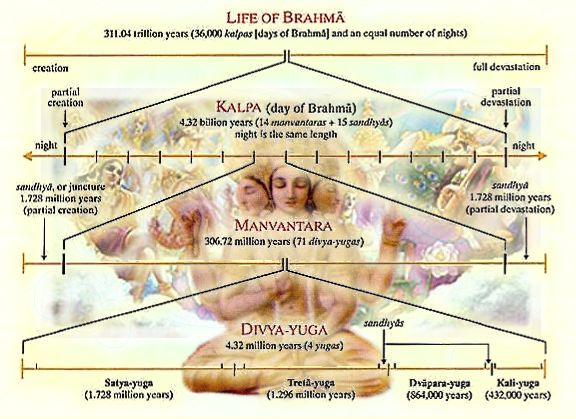No products in the cart.
“Paritranaya Sadhunam, Vinashaya Cha Dushkritam,
Dharmasamsthapanaarthaya, Sambhavami Yuge Yuge!”
“For the protection of the good and the destruction of the evil,
For the purpose of reinstating righteousness, I shall incarnate in every Yuga!”
The above were the words spoken by Krishna in a revelation he made about his own divinity to Arjuna, during the Great War of Kurukshetra.
What is a Yuga?
According to Hindu philosophy, the world is made up of four main “Yugas” – ages, epochs or cycles of time – each made up of tens of thousands of human years. These 4 yugas are the Satya Yuga, the Treta Yuga, the Dvapara Yuga and lastly, the Kali Yuga. According to the laws of Hindu cosmology, the Universe is created wholly, only to be destroyed entirely, once in every 4.1 to 8.2 billion years. This is believed to constitute one full day and night for Lord Brahma, the Creator of the Universe. One Brahma’s lifetime is considered to be around 311 trillion and 40 billion years. These Yugas are believed to repeat themselves in cyclical patterns, much like the waxing and waning of the moon; like the four seasons; like the rising and ebbing of tides.
Each of these four Yugas involves stages of change; of evolution; one in which not only the physical universe undergoes change, but the whole thought process and consciousness of mankind metamorphoses either for better or for worse, depending upon that particular Yuga. The entire cycle of a Yuga starts from its highest point, the Golden Age of enlightenment. From there, it gradually proceeds stage by stage, till it reaches a Dark Age of evil and ignorance, again moving ahead towards positivity, reaching back to the Golden Age, in order to complete the cycle. One entire cycle of the Yuga, Hindus believe, denotes the time the solar system takes to revolve around another star.
Time Duration of Each of the Four Yugas
According to the Laws of Manu, which was the earliest known text describing the four yugas in detail, the length of each Yuga is as follows:
4800 years + 3600 years + 2400 years + 1200 years, which equals 12,000 years. This figure denotes only a half cycle and hence, the entire cycle takes 24,000 years to complete. This is also one precession of the equinox.
There is no clear mention here of the exact span of a year of life for demigods. However, the most recent interpretation of the Shrimad Bhagavatam seems to indicate that the duration of the Satya Yuga is equivalent to about 4,800 years of the demigods; the duration of the Dvapara Yuga is about 2,400 years; and that of the Kali Yuga is about 1,200 years of the demigods. Hence, one could probably infer from these statistics that one year of a demigod would be the equivalent of about 360 human years.
This would also lead us to believe that the Satya Yuga lasted for 4,800×360, that is, about 1,728,000 years. The Treta Yuga, on the other hand, went on for 3,600×360 years, which works out to 1,296,000 years. Similarly, the Dvapara Yuga continued for 2,400×360, that is, 864,000 years. The Kali Yuga is supposed to be the shortest of them all, lasting for only 1,200×360 years, which totals to 432,000 years. From the aforementioned statistic, it can be understood that the four Yugas follow a timeline ration of 4:3:2:1.
As mentioned earlier, each subsequent age is witness to a gradual decline of wisdom, knowledge, intellect, life span, physical and spiritual strength in humankind as a whole. This automatically also implies decline and destruction of dharma or righteousness.
Satya Yuga
Dharma reigned supreme at this time, with human stature being estimated at 21 cubits. The average human lifespan at this point in time was 100,000 years.
Treta Yuga
This Yuga witnessed the decline of virtue to a quarter of the previous one. Human stature was valued at 14 cubits and average human lifespan was 10,000 years.
Dvapara Yuga
Virtue and sin were divided into equal halves. Normal human stature was 7 cubits and human lifespan went down to 1000 years.
Kali Yuga
This Yuga has only one quarter virtue and the rest is taken over by sin. Human stature is reduced to 3.5 cubits and average human lifespan is about 100 years. It is believed that, towards the end of this terrible Dark Age, average human lifespan would go down to 20 years.
SATYA YUGA
Amongst the four era’s, the Satya Yuga is the first and the most significant one. This era began on Sunday, Vaishakh Shukla Tritiya day which is also known as Akshaya Tritiya. This extends up to 17, 28,000 years. God incarnated in four forms i.e. Matsya, Kurma, Varaha and Narsimha in this era. Knowledge, meditation and penance would hold special importance in this era. The average height of people was more than what it is today. Every king would attain the pre-determined attainments and would experience bliss. All the four pillars of religion i.e. truth, penance, yagna (religious sacrifice) and charity were present in totality. The only text which was considered credible and was followed was Manu’s Dharma Shastra. Satya Yuga shall be established by Kalki again after the Kali Yuga.
At the end of this era when the Sun, Moon, Jupiter together enter Pushya Nakshtra that is the Cancer Zodiac then the Satya Yuga shall begin. During this time the stars/constellations shall become auspicious and radiant. As a result it shall accrue in the wellbeing of all creatures and the health will ameliorate. It is during this auspicious time that Vishnu’s Incarnation Kalki shall take birth in a Brahmin family. After this all the generations to come shall follow the ideals established by Bhagwan Kalki and shall engage in religious activities. Accordingly on the advent of the Satya Yuga all people shall engage assiduously in good, sublime deeds.
One shall witness the emergence of beautiful gardens, Dharmasthanas (Resting Inns) and majestic temples. One shall see the execution of many a huge yagyas. Brahmins, sages, ascetics according to their nature shall be absorbed in penance. Ashrams shall be devoid of the wicked and the deceits. This era shall usher better agriculture and one shall be able to grow all food grains in all seasons. People shall generously donate and will follow all the rules and regulations mentioned. The kings shall protect their subjects and earth very sincerely.
TRETA YUGA
One sees the advent of religious sacrifices i.e. Yagyas in the Treta Yuga. One pillar of the four pillars of religion meets its end. People in this era will be truthful and would perform all the religious ceremonies according to the sacrifices. It is the Treta Yuga where one can see the overtures of Yagyas, religion and allied activities. People would beget desired fruits by performing actions, donations mentioned in the Vedas and by taking resolutions.
All people in this era were assiduous and active. The main religion of Brahmins was truth that is truthful speech, good conduct and love towards all creatures. The common religion of all the Brahmins was Yagyas, self-study and donation. The primary aim of Shudras was service towards Brahmins, Kshatriyas and Vaishyas. The duties of Kshatriyas and Vaishyas were the protection of people and agriculture, trade and poultry respectively. All people would sincerely adhere to their respective duties and as a result they would be blessed with celestial bliss.
The average life expectancy of a human in the Treta Yuga was approximately 3000 years. All the Kshatriyas born in this era were valiant, zealous, big thinkers, pious, truthful, beautiful, suitable to be blessed, revered and the protectors of all people.
DWAPAR YUGA
There are only two pillars left of religion in the Dwapar Yuga. People were engaged only in penance and charity. They were kingly and pleasure seeking. In this era, the divine intellect ceased to exist, hence seldom anyone would be truthful. Consequently people were plagued by ailments, diseases and various types of desires. After suffering from these ailments people would perform penance. Some would also organize yagna for material benefits as well as for divinity.
The Kshatriyas in this era were humble and performed their duties by controlling their senses. The king would avail to the advice of the learned scholars and accordingly would maintain law and order in his empire. The king who was addicted to vices would definitely end up defeated. Kings were diligent in maintaining public decorum and order.
Kings would plan many a conspiracy surreptitiously along with the scholars. Strong people would execute work where execution of policies was involved. The king would appoint priests etc to perform religious activities, economists and ministers to perform monetary activities, impotent to take care of women and cruel men to execute heinous activities
Brahmins would attain celestial bliss by engaging in penance, religion, control of senses, restraint, yagna etc. Vaishyas would attain higher planes through charity and hospitality. The Kshatriyas would honestly execute all policies of law and order without being angry, cruel and being devoid of greed and consequently attained bliss. All people in this era were zealous, valiant, courageous and competitive by nature.
KALI YUGA
The duration and chronological starting point in human history of Kali Yuga has given rise to different evaluations and interpretations. According to the Surya Siddhanta, Kali Yuga began at midnight (00:00) on 18 February 3102 BCE in the proleptic Julian calendar, or January 3102 BC in the proleptic Gregorian calendar. This date is also considered by many Hindus to be the day that Krishna left Earth.
Hindus believe that human civilization degenerates spiritually during the Kali Yuga, which is referred to as the Dark Age because in it people are as far away as possible from God. Hinduism often symbolically represents morality (dharma) as a bull. In Satya Yuga, the first stage of development, the bull has four legs, but in each age morality is reduced by one quarter. By the age of Kali, morality is reduced to only a quarter of that of the golden age, so that the bull of Dharma has only one leg.
References in the Mahabharata of Yugas
The Mahabharata War and the decimation of Yadavas thus happened at the Yuga-Sandhi, the point of transition from one Yuga to another. The scriptures mention Sage Narada to have momentarily intercepted the demon Kali on his way to the Earth when Duryodhana was about to be born in order to make him an embodiment of ‘arishadvargas’ and adharma in preparation of the era of decay in values and the consequent havoc.
Most interpreters of Hindu scriptures believe that Earth is currently in Kali Yuga.







